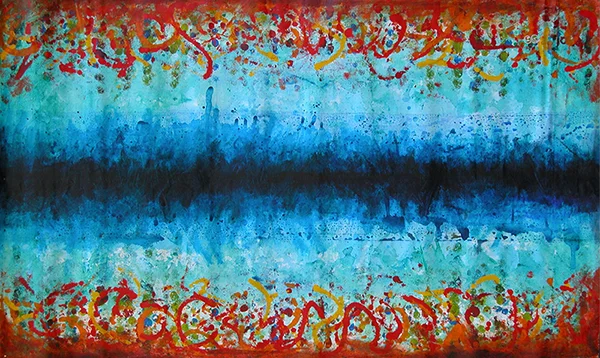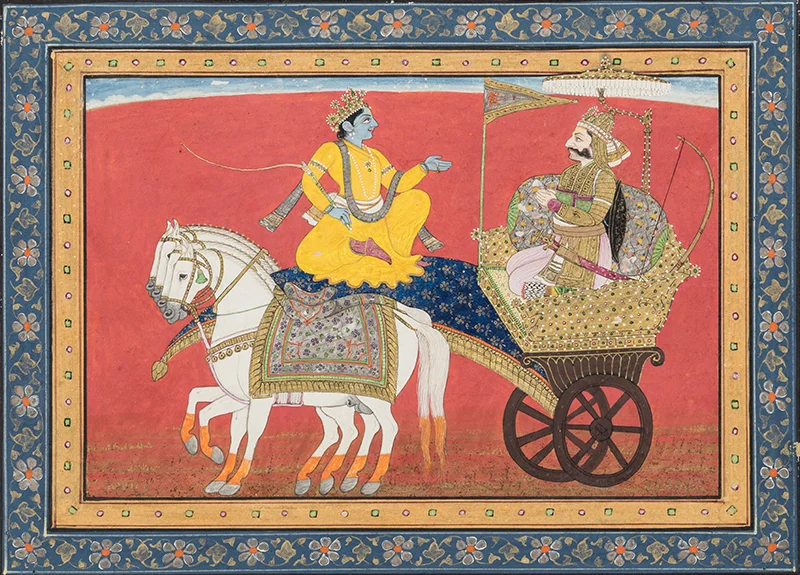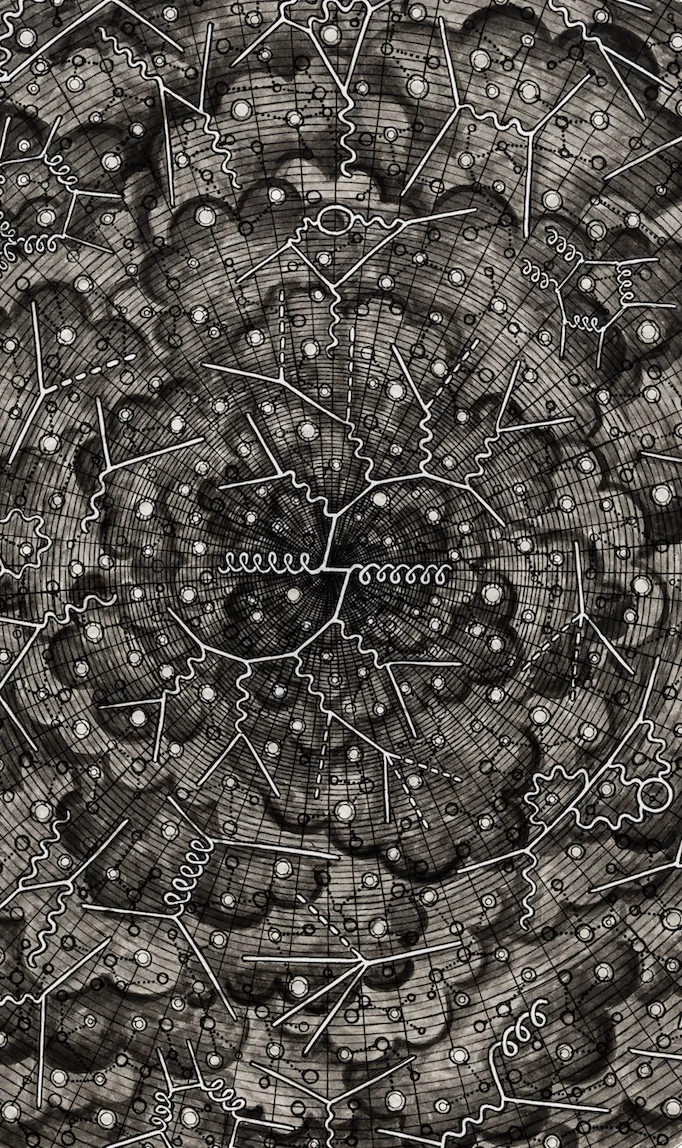
- MOVEMENT I: ARJUNA'S LAMENT
- MOVEMENT II: FIELD OF BATTLE
- MOVEMENT III: DILEMMA
- MOVEMENT IV: REALIZATION
Field of Dharma
A concerto-kriti in 4 movementsSetting
“Dharma-kshetre kuru-kshetre”
On the field of dharma, the field of battle
With these words, the blind king Dhritarashtra sets the Bhagavad Gita in motion. This Sanskrit text’s opening words are instantly recognizable across India, as they begin the story of a 3000-year old battle at once physical and metaphysical. Dhritarashtra speaks of the fight about to begin on the field of Kuru, the site outside Delhi where the Pandava and Kaurava factions of the Kuru dynasty will clash in their struggle for the kingdom. Lines of foot soldiers, battle elephants, and horse-drawn chariots face one another, and face the coming eighteen-day battle that by legend will leave the soil of Kuru dyed permanently red. The field of Kuru, Dhritarashtra tells us, is also the field of dharma, the site of a moral struggle over duty, over the right and true way. The Pandava prince Arjuna, finding himself at the center of both, looks out across the battlefield, sinks into his chariot, and lets his bow and arrows clatter down beside him. He turns to his charioteer, the Lord Krishna, and says: “I am unstrung.” His fight is at once physical, moral, and cosmic. As Arjuna finds himself unstrung, so too can the readers of the Gita find themselves unstrung in their own lives, unsure of the right path as they consider their own places on the field of dharma.
Movement I (Pallavi) – Arjuna’s Lament
“I have no desire to kill them, even for the kingship of all the three worlds.”
Arjuna, Bhagavad Gita 1:35
Bhishma, Drona, Kripa: these are the faces that Arjuna sees as he looks across the field of Kuru. His opponents are his cousins and teachers, his childhood playmates and mentors, who taught him how to shoot the very bow that will now kill them. The Carnatic violin unfolds Arjuna’s lament, the recurring theme of the concerto: “my mouth is dry, there is a trembling in my body, and my hair rises, bristling.” As his turmoil increases, the trumpet dovetails with the violin and veena, mirroring Arjuna’s own lament in a way that binds any possible victory to shattering grief.
Movement II (Anupallavi) – Field of Battle
The warrior Bhishma roars and blows his conch for his army to hear. Kettledrums, cymbals, and trumpets resound across the field of Kuru as Kauravas and Pandavas alike take up the call. The young warriors shift their weapons from one hand to the other, eager to prove themselves for the first time, while experienced ones are more somber. They know what it means to fall on these fields; they know what the plains of Kuru will look like after eighteen days. The oboe’s spare, stepwise lines anticipate the return of Arjuna’s lament, which descends into the glissandi of a harp cadenza. Overcome with sorrow, Arjuna drops his bow and slumps down in his chariot.
Movement III (Charanam) – Dilemma
“Abandon your faintheartedness, rise up, O Scorcher of the Foe,” the Lord Krishna admonishes Arjuna. The strings intervene in homophonic blocks with sharply defined articulation and close harmonic spacing. There is no opening here, no room for negotiation. If Arjuna does not fight, he betrays his own people. The Kauravas have driven the Pandavas from their homes and into the jungle, where the Pandavas face hunger by day and wild animals at night. And yet, Arjuna protests that he cannot kill his own teachers: “all my earthly pleasures would be smeared with blood.” The lines of the violin and trumpet alternate between lyrical lines and jagged rhythms. Arjuna asks: would it be worse to lose this war, or to win it? Arjuna’s mind cycles around itself, alternating between duty and compassion, decision and indecision, point and counterpoint — until a gong tolls, marking a cosmic pause.
Movement IV (Swaram) – Realization
Arjuna experiences a moment suspended between despair and decision, between the human and the divine. In this moment the Lord Krishna delivers his fundamental teachings, evoked in a swaram form. The swaram section is typically improvised, as in jazz, where melodic explorations return to a theme at a fixed point in the rhythmic cycle. Here the low, sonorous strokes of the mridangam evoke a cosmic cycle of birth, destruction, and renewal that forms the rhythmic and conceptual basis for Krishna’s revelation. The violin, veena, and oboe are counterpointed against one another in long, arching lines which disclose the cosmic clarity that structures a human life: self beyond ego, action beyond attachment.
The tempo accelerates and the lines overlap to condense and intensify the rhythm, and then Krishna reveals himself: He is all the colors, all the creatures, from the seers to the serpents to the lotus-seated Lord Brahma Himself. He swallows whole worlds and brings forth new ones, as the deathless and all-sustaining creator and destroyer who transcends being and non-being. The limitations of Arjuna’s perspective are shattered from within: “With every mouth ablaze, you lick with flaming tongues the worlds which on every side you swallow.” Arjuna’s theme returns, this time not as a lament, but rather as an affirmation of his own position within the whole. The trumpet’s rising line lifts the concerto to its conclusion, where the mridangam’s cosmic pulse drives the unison of the violin and veena. A crash resounds: Arjuna takes his place on the field of dharma.

(Sections above are excerpts from the album’s liner notes.)
Kriti Structure
A kriti’s form (described in greater detail in the Fugue-Kriti page) could be schematically described as A BA CBA with each of the A, B, and C sections featuring a theme and subtle variations (the statements of the theme and variations are called sangathis).
This concerto-kriti uses the kriti’s form mentioned above (A BA CBA) as follows:
- Movement I (Pallavi): A
- Movement II (Anupallavi): BA
- Movement III (Charanam): C; the sangathis are introduced by the violin
- Movement IV (Swaram, in a continuation of the Charanam): BA, with improvisatory passages — called swaram — that each lead into the return of the B theme
While this concerto-kriti follows a kriti’s framework, it departs from a strict kriti structure by featuring substantial interludes between the various sangathis (unlike in the Fugue-Kriti).
It also diverges from the traditional concerto form by emphasizing interaction between soloists within an orchestral context, rather than primarily between a soloist and the orchestra. Counterpoint is a distinctive feature of these interactions.
Ragas and Tala Used
The Pallavi and Charanam (A and C sections) are set in raga Shanmukhapriya, with the scale E F♯ G A♯ B C D E.
The Anupallavi (B section) is in raga Charukesi, with the scale E F♯ G♯ A B C D E.
The tala is Adi, an 8-beat rhythmic cycle.
Instrumentation
The concerto-kriti is scored for the following instruments:
Principal soloists: Carnatic violin and veena
Mridangam
2 flutes, 2 oboes, 1 English horn, 2 clarinets, 1 bass clarinet, 2 bassoons
2 horns, 2 trumpets, 1 trombone
Timpani, tam-tam, snare drum
Harp
Strings: approx. 6–5–4–4–3
Field of Dharma is part of the album
Confluence: Raga and Counterpoint
Album

Featured Soloists in Field of Dharma:
Shraddha Ravindran, violin
K.R. Shrievats, veena
Mannarkoil Dr. J. Balaji, mridangam
Label: IndianRaga
Release Date: September 2025
